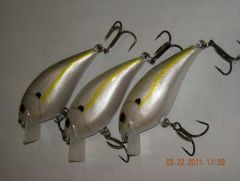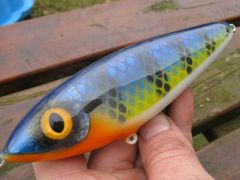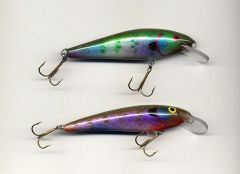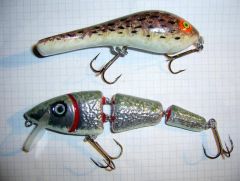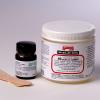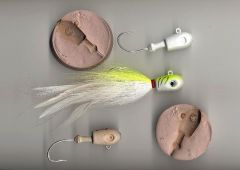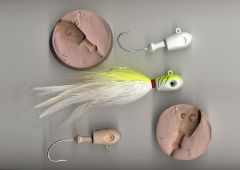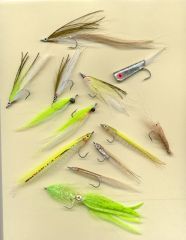-
Posts
149 -
Joined
-
Last visited
-
Days Won
2
Content Type
Profiles
Articles
TU Classifieds
Glossary
Website Links
Forums
Gallery
Store
Everything posted by woodenfeather
-
-
-
-
Hey Wingnut, I used to fish for perch through the ice out in Michigan. Mostly after walleyes though. One thing I liked to do for perch, gills and crappies was to use a teardrop jig tipped with a spike but also tie a fly on a short dropper loop about 8 or 10 inches above the jig. I also tied weighted flies like your talking about with good success. Black with a little red, if I remember right,was killer. It helps when you can watch them eat the fly on your camera, cause without bait they spit it out immediately.
-
-
Hi Mark, The epoxy adheres to the lure no problem, it's the plastic it doesn't stick to. I should have prefaced this by saying I do use epoxy for this application and have since I started making lures. I was just wondering if there was something better you guys were using. S 54, Thanks for the info. I did some searching and found some stuff that would be perfectly suited for this application in every way but, like you found, the cost. 3M makes a product called scotch weld DP 100 that looks good but you have to buy a gun and tips. The working time is too short also. We used this stuff at work a while back that I think would be awesome. It welded the acrylic, and the drops that spilled on the plywood work table are still there. My only concern, other than price, is I think it might be too brittle. If I can justify it as a work expense I'll get some and try it. Here's a pic.
-
Thanks for the replies. I like the idea of mixing solvent into the epoxy! I think I read somewhere that they sometimes use acetone to weld acrylic. As far as it clouding up, if it's anything like acrylic, it turns optically clear when you glue it.(unless it's humid, then it will blush just like lacquer). I thought maybe I was missing something because when I look at some lures like rapalas, they have a very strong glue joint at the lip. You'll break it before it will come loose. When I use epoxy, I can remove the lip without to much damage to the lure. I am going to get in touch with the company that supplied us with the acrylic adhesive at work. I'll let you know if I find something better.
-
Hi Guys, Just wondering what the experts use to glue their diving lips into wooden lures. I've been using epoxy but I have to drill small holes or carve grooves into the lexan to get it to hold. After working with acrylic on some work related projects and seeing how they chemically weld the stuff, is there a solvent glue that bites into the lexan and also grips the wood? Thanks for any suggestions.
-
I use 220 or 320 when sanding between coats. The 220 does leave visible sanding marks in the finished paint. The reason you need to sand between coats is not only to smooth out any bumps but to take off the gloss so the next coat can mechanically bond to the surface. I am certainly no expert but ,having made every mistake possible, I would caution you about applying the spray rustoleum primmer over the poly. I am not sure why but the solvents in a lot of that stuff can cause the poly to reactivate and wrinkle up if its not completely cured.
-
Excellent job especially for your first attempt. I've done several foiled lures and I still can't get them to look that good. The scales look awesome, If your lazy like me and are using a relatively soft wood under the foil, you can hold the mesh tight to the lure after you've applied the foil and carefully emboss it using a small laminate roller or a hard dowel rolled over the surface. Also check out "Making wobblers by hand part 2" on youtube. Start watching at 3:20 to 6:15. Both 1 and 2 are great videos but the part where he's applying the foil made me sick at how easy he does it. I wish I knew what he was saying and where to get the pre-embossed foil he's using! Enjoy
-
-
-
-
Hey Mac, If I understand your problem correctly I'd suggest building the body farther back and slightly up the bend. That way the hook is more perpendicular to the strip when it butts against the body.
-
What bugs me is the fact that since I started making flies and lures, I can't get myself to just go out and buy 'em anymore. If I get into something new like using spinnerbaits, I can't be satisfied with buying an assortment and stickin em in my tackle box. Instead I have to buy a mold and hooks, wire, paint, blades, swivels and skirts. Read books on how to design them, and try and dream up ways to improve on designs that have already stood the test of time. I do all this knowing full well I don't have any intentions of selling anything I make. What the hecks wrong with me?
-
Party crasher, I don't secure the zonker at the bend with thread as the hide is very strong and has never torn where the hook goes through. I do however put a drop of glue on it right where the hook goes through when the jig is finished, so it wont slide up the hook if the skin stretches. As far as weight, I make 'em from 1/8 to sometimes 5/8 ounce. Since moving to MA. I've gotten into saltwater and have made some 1 to 4 ounce monsters. To answer your question about the flash, I sometimes use ice, pearl and metallic tinsel chenille. I also use mixes of hair and flash and form a dubbing brush. If you want to put a mono weed guard on it, slide the strip to the head after pushing the hook through, then tie the mono onto the hook to about 1/3 around the bend. Then slide the strip back and over the wraps, tie on the body and pull the strip tight up against it. Tie the strip off at the head and then tie the weed guard with just enough wraps to hold it but still allowing you to slide it. Cut it a little long and use a lighter to melt a ball on the end. Then pull the guard back so the ball is up against the wraps and tie off. Glue the head and tail.
-
I love tying jigs with rabbit too. I like to push the hook through the zonker strip, tie on a body of chenille and hackle, and then pull the strip tight up against and over the body and tie off at the head. I used to slay the smallies in a local river with these jigs in mostly natural colors. The rabbit breathes so well that most of the takes were when I was dead stickin it. If you want to try another pattern that has proven deadly on all fish, then tie up some wooly buggers. Use webby hackles to add bulk and movement.
-
I've been doing the same thing with great results. I dip the head in a base color, sprinkle on some secondary colors, let it cool and then add stripes and detail with a permanent marker, then reheat and sprinkle on clear with glitter. Then I cure them in the oven as per the manufacturers directions. Another thing I tried and turned out neat was to use permanent markers on the bare lead and then dip into a transparent color. Like pickerel Pete said, you have to cure them after you add your details.
-
I'm not sure what war eagle uses as I've never seen one, but if they are metal, they probably are using leader sleeves as spacers.
-
Some guys prefer to use rosin core and use a soldering iron. I've been using some lead-free solder for plumbing, due to the fact that I have a bunch of it, and use a water soluable flux with a propane torch. You have to be careful doing it this way though because it's extremely easy to overheat the blade and hook, which weakens the hooks and discolors the plating, but not hot enough and even though the solder flows it might not adhere to the blade/spoon. I'm not sure if this is the "right" way to do it as no one showed me how, but its worked well for me and i've made thousands. I think this would be a good subject for a tutorial!!
-
Thanks for the tips. Richoc, I clean them pretty much the same way after soldering but they usually get painted right away. I am going to try your suggestion to get the oxidization off.
-
Hi guys, I cranked out a bunch of tiny ice-jigs earlier this spring but didn't get a chance to paint them. Well, now they are oxidized and I have so many and they are so small that I don't want to have to clean them by hand. Is there something I can soak them in that would eat the oxidization away without ruining the gold plating on the hook or the nickle plating on the blade? Any suggestions would be greatly appreciated!
-
Thanks cotton, I appreciate the info. I am going to get the baits you suggested and look into getting the book as well. Unfortunately there isn't squat around here as far as tackleshops go. Everything is geared towards saltwater. If I have any success I'll let you know. Thanks again, Dan
-
Hi Guys, I just recently moved to MA and have been trying to figure out the large mouths out here. I am relatively green when it comes to Large mouth Bass but I can usually hold my own. There is a pond about a mile away that I've been trying to figure out and want to get some input from some of you bass fisherman. Here's the deal, it's a relatively deep(45') pond with very little vegetation or cover. The water is crystal clear. You can go down there any time of day and catch a fair number of bass in the 1 to 2 pound range using a variety of methods. I had heard people talking about huge bass in there but was skeptical until the other day. I was casting to some blow-downs with a 6" watermelon seed lizard when, after catching 4 of the dinky ones, I hooked and barely landed a Bass of about 7lbs. Now that I am a believer I want to try to zero in on these hogs. Most of the stories I hear come from the trout fisherman. One guy say he had a big trout ripped off his hook by a huge bass right in front of him. Others say they've seen giant bass pestering the trout they have out on a stringer. Should I be using a big rainbow trout swim-bait? If so should I be targeting cover/structure or looking for suspended fish. I am usually fishing from shore as they only allow car top boats in this pond. Here is a crude map of it. http://www.mass.gov/dfwele/dfw/dfw_pond/dfwdugg.pdf Any suggestions would be greatly appreciated!! Dan
-
Thanks for all the good tips guys! I sure do appreciate it.




